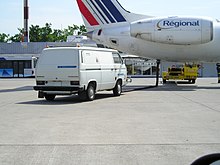Ground launch device
An air-start system ( English air starter unit or air start unit, ASU ) is a ground support unit for standing on the ground aircraft, the compressed air supplies to start the turbines. The ground starting device can also be combined with a ground power unit (GPU) and then provides additional power.
A jet engine has to start at a speed of about 15 to 20% of the maximum speed will be accelerated before the fuel supplied into the combustion chambers and the continuous combustion process can be started. The on-board auxiliary power unit (APU) is normally used for this . However, if the APU fails, the airport operator, a service company or the airline will provide a ground launch device. Aircraft entirely without an APU (such as the Boeing 707 ) are still used today in military aviation, but rarely found in civil aviation.
Depending on its performance, the ground starter is a compressor with diesel drive or a gas turbine with bleed air extraction (similar to an APU), which is mounted on a trailer, small van or truck. The compressed air generated by the compressor is fed with a hose to a special connection coupling on the aircraft skin and then reaches the starter of the engine via pipes in the aircraft.
The on-board air conditioning system can also be operated with the compressed air from the ground starter. Modern devices also offer electrical energy, for which a separate ground power unit was otherwise required, as well as the large amounts of air required for modern large engines.
